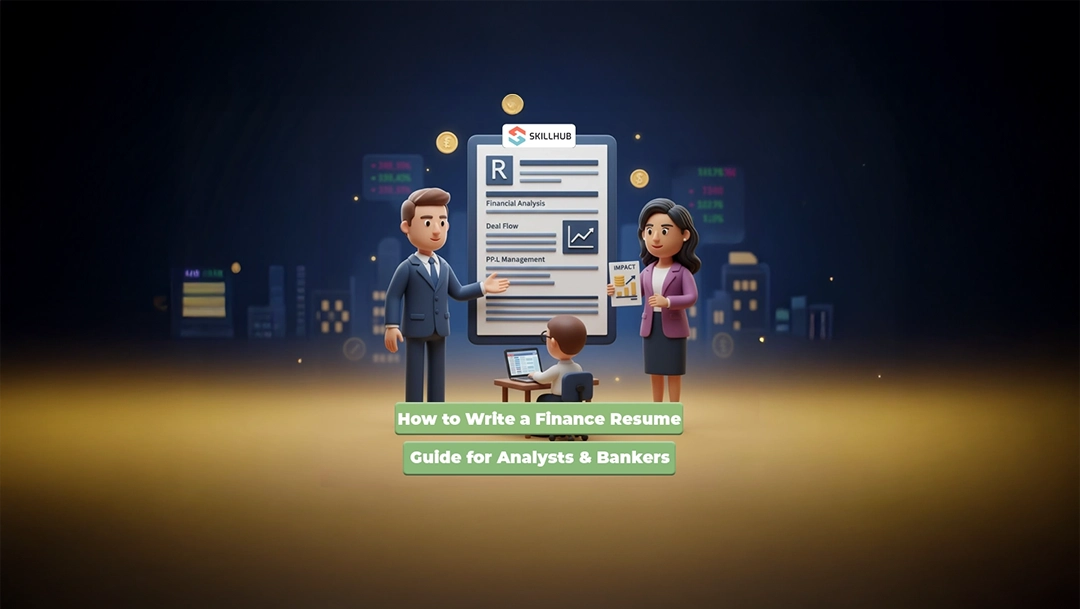How to Write a Finance Resume: A Guide for Analysts, Bankers, and Accountants

In the world of finance, your resume is not a personal history. It is an investment prospectus. It is your first financial report, and it will be scrutinized with the same intensity as a 10-K filing. This is a YMYL (Your Money or Your Life) industry, and the standards are punishingly high. Recruiters at top-tier investment banks, private equity firms, and accounting giants are not looking for "creativity" or "personality." They are looking for precision, quantifiable impact, and zero errors.
A single typo, a misaligned margin, or a vague bullet point is not a small mistake it is a critical failure. It signals a lack of attention to detail, which is the mortal sin of the finance industry. Your resume must survive four distinct levels of screening: the ATS (Applicant Tracking System), the junior HR screener, the analyst (who will tear your technical skills apart), and the Managing Director (who will make the final call in seconds).
This is a high-stakes document where your E-E-A-T (Experience, Expertise, Authoritativeness, Trustworthiness) is everything. This guide provides the definitive, no-nonsense framework for building a resume that can survive this gauntlet and prove you are a low-risk, high-return asset.
The Foundational Mindset: Your Resume is a Financial Model
You must build your resume the same way you would build a financial model: with a rigid structure, impeccable formatting, and a relentless focus on the data. Every entry must be defensible, clear, and add tangible value. To build strong fundamentals for exams like the SIE, you can try FINRAPracticeTests, which helps reinforce your technical credibility as a candidate.
In finance, "creative" formatting is a liability. Recruiters are trained to scan a very specific, conservative, single-column format. They need to find your GPA, your experience, and your Excel skills in under six seconds. A flashy, design-focused resume is an immediate red flag that you don't understand the industry's culture.
When I'm reviewing a stack of 200 resumes for an analyst position, I'm not looking for flair. I'm looking for 'data density.' How much quantifiable impact did you have? How complex were the deals? And did you make any mistakes? A typo on a resume for a banker is like a calculation error in a model. It's finished. We throw it out.
Core Sections for Every Finance Resume (The Non-Negotiable Structure)
The order and content of your sections are critical. For candidates still in school or recently graduated, Education always comes first. For experienced professionals, Education moves to the bottom.
Education (The "Target School" and GPA Filter)
For investment banking (IB), private equity (PE), and consulting, this section is a primary filter.
- Where it Goes: If you are currently a student or graduated in the last 1-2 years, this section goes above your Work Experience.
- What to Include:
- University Name & Location: (e.g., University of Pennsylvania, The Wharton School, Philadelphia, PA)
- Degree & Major: (e.g., Bachelor of Science in Economics, Concentration in Finance)
- Graduation Date: (e.g., May 2024)
- GPA: This is non-negotiable in finance. If your GPA is 3.5 or higher, you must include it. If it's lower, recruiters will assume the worst, so be prepared to justify it.
- Honors/Awards: (e.g., Magna Cum Laude, Dean's List (8 semesters)).
- Relevant Coursework: This is useful for entry-level candidates to list keywords. (e.g., Relevant Coursework: LBO Modeling, Corporate Valuation, Fixed Income Analysis).
This is the first and easiest way for firms to cull the applicant pool. Ensure your education section is flawless.
The Work Experience Section: The Language of Money
This is the heart of your prospectus. You must speak the language of finance, which is the language of numbers. Do not ever list your responsibilities. You must list your impact and deal flow.
Every bullet point must be a powerful action verb followed by a quantifiable result.
Your metrics must focus on three things:
- Deal/Transaction Value ($): "Analyzed a $500M potential acquisition in the industrial sector..."
- Impact/Savings (%): "Developed a new forecasting model that improved revenue projection accuracy by 15%..."
- Efficiency/Time (Time): "Automated a month-end reporting process, saving 20 hours of manual work per month..."
The Technical Skills & Certifications Section
This is your technical proof. "Microsoft Office" is a wasted line. You must be specific and advanced. This is where you prove you have the hard skills to do the job on day one.
- Good Example (Analyst):
- Technical Skills: Advanced Excel (Pivot Tables, VLOOKUP, Index/Match, Macros), Financial Modeling (DCF, LBO, 3-Statement), Bloomberg Terminal, CapIQ, Pitchbook, Python (Pandas)
- Certifications: CFA Level II Candidate, Siebel Certified
- Good Example (Accountant):
- Technical Skills: QuickBooks Enterprise, NetSuite, SAP, Advanced Excel, SQL (for data extraction)
- Certifications: Certified Public Accountant (CPA) - Licensed in New York
Tailoring Your Resume: Banker vs. Analyst vs. Accountant
A "finance resume" is not one-size-fits-all. The evidence you present must be radically different based on the role.
Strategy for the Investment Banking (IB) Analyst (Focus: "Deals")
- Your Audience: Associates and Vice Presidents (VPs) who are overworked.
- What They Care About: Deal experience and stamina. Can you handle the 100-hour weeks? Can you build a model from scratch?
- Key Language: "M&A," "Deal Flow," "Due Diligence," "Valuation," "Pitch Book," "LBO/DCF Modeling."
- Example Bullet Points:
- "Supported 3 live M&A sell-side transactions for clients in the TMT sector with enterprise values ranging from $200M to $1B."
- "Built and maintained complex 3-statement operating models, LBOs, and DCF analyses to evaluate potential acquisitions and investment opportunities."
- "Conducted in-depth company and industry due diligence for a $300M IPO, interfacing with legal, accounting, and client management teams."
Strategy for the Corporate Financial Analyst (FP&A) (Focus: "Impact")
- Your Audience: A Finance Manager or Director of FP&A.
- What They Care About: Internal impact. How did your analysis change the company's decisions? How well do you understand the business operations?
- Key Language: "Forecasting," "Budgeting," "Variance Analysis," "P&L Management," "Cost Reduction," "Reporting."
- Example Bullet Points:
- "Managed a $45M annual operating budget for the marketing department, conducting monthly variance analysis and reporting directly to the CMO."
- "Identified $1.2M in annual cost-saving opportunities by analyzing vendor contracts and proposing an alternative fulfillment strategy."
- "Developed a new 12-month rolling forecast model in Excel, which improved forecast accuracy from 85% to 98% and was adopted by the entire division."
Strategy for the Accountant (CPA) (Focus: "Accuracy")
- Your Audience: A Controller or Accounting Manager.
- What They Care About: Accuracy, compliance, and process efficiency. Did you close the books on time? Did you pass the audit?
- Key Language: "Month-End Close," "Reconciliation," "SOX Compliance," "GAAP," "Audit," "Process Improvement."
- Example Bullet Points:
- "Managed the full-cycle month-end close process for a $100M division, reducing the close timeline from 5 days to 3 days."
- "Led the preparation for the annual 'Big Four' audit, resulting in 'zero material weaknesses' for 3 consecutive years."
- "Automated the accounts payable reconciliation process using Excel macros, eliminating 40+ hours of manual data entry per month."
The Expertise Barrier: The "Zero-Tolerance" for Error
This is the ultimate "pain point" and the reason why this is a YMYL document. In finance, a mistake on your resume is not a typo; it's a character flaw. It demonstrates a lack of attention to detail, which is the single most important trait in the industry.
- The Alignment Test: Are all your dates right-aligned perfectly? Are all your bullet points indented to the same exact spot?
- The Consistency Test: Did you use "M" for millions in one place and "MM" in another? Did you use "Q3 2023" in one entry and "09/23" in another?
- The Typo Test: One spelling mistake. Just one. And you're out.
Recruiters use these tiny, seemingly pedantic details as a proxy for the quality of your work. If you can't be trusted to perfect your own resume, you can't be trusted to build a model that will decide a $500M deal. This is why many candidates use a professional service, not just for writing, but for the obsessive-compulsive proofreading that is required.
Conclusion: Your Resume is Your First Financial Report
Your finance resume is the first and most important financial report your future employer will ever see: a report on you. It must be clean, precise, data-dense, and utterly free of errors. It must prove, in under six seconds, that you are a low-risk, high-return asset. By focusing on quantifiable impact, speaking the language of your specific niche, and formatting with obsessive precision, you will build a document that withstands the scrutiny and lands the interview.
Ready to ensure your resume is as flawless as a balance sheet? Consult with a Skillhub Career Expert today to get an expert review that meets the exacting standards of the finance industry.
%20(1).png)



%20(1).webp)